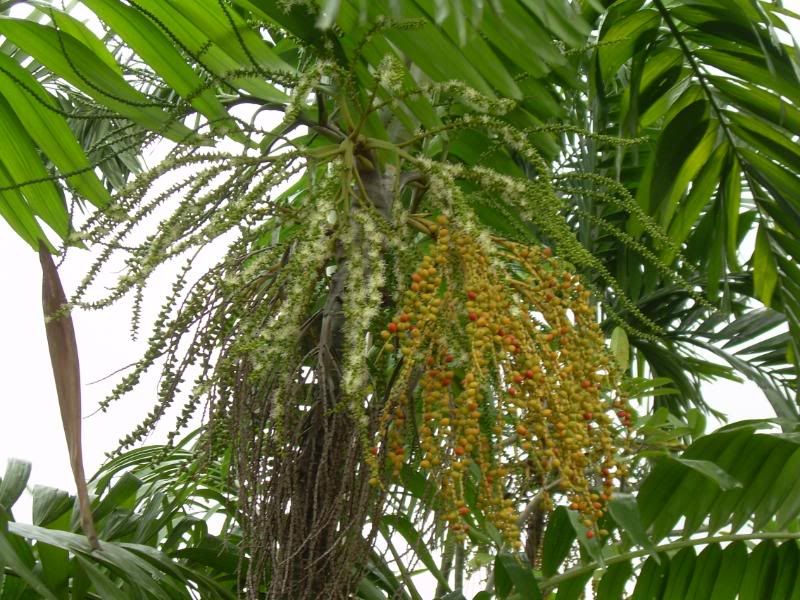Hello Gentleman,
Ed here from Los Angeles. I just found the forum yesterday. It was BODs article that I first found; I was looking for additional info on palm fiber tinder. I stayed up till 2:30am reading this entire thread and have to say that you guys would be a great lot to hang out with.
As for me, I've learned all primitive friction methods and found local materials that work well. As for the fire thong, I have great success using California Buckeye (_Aesculus californica_) and can give details later if people are interested. As for the thong, simply go to a furniture shop and buy the rattan or you could also use what is called 'binding cane'.
O.K. as for Palm tinder for fire pistons and bamboo on crockery. I have some additional info that you may or may not have come across and I hope that it will give you success in your quest.
Most of the literature that I have found lists palm tinder coming from the subfamily Caryotoideae (Fishtail Palms).
Arenga pinnataand
Caryota mitisbeing the most common.
Chamaerops ritchiana is used in Pakistan,
Elaeis melanococca is used in Brazil,
Caryota urens is used in Lakhimpur (India) and so on.
I see that you guys love the scientific literature as well and here are a couple that relate to the topic that you may have fun looking up.
'Useful Palms of the World, a synoptic bibliography' by Michael Balick, 1990.
This amazing book lists numerous palms used for tinder. Most are in the subfamily Caryotoideae. Oh yeah, I'm a greenhouse manager at California State University Fullerton so I love the plant talk.
'Fire-making using a stone 'strike-a-light' in the Soa Basin of Flores, Indonesia' Adam Brumm. You can find this article and video online. This is a must read and see, especially for BOD. You are my second find for a reference for adding charred material to the palm fiber to prepare the tinder and it really works great! Oh, the people use charred coconut fiber for the additive to the palm fiber. More on this later.
'Palms of Malaya' by T.C. Whitmore, 1977. You guys will love this one. on page 45 it reads: "The fluff which can be scraped off the leaves and sheaths is used for tinder. In Kelantan
gobek api is a remarkable means of making fire by friction and compression utilizing this tinder. A piece of buffalo horn has a 1/4" hole drilled in it and a tight fitting piston of the same material; a little tukas fluff is dropped into the hole. The piston id driven sharply home, and if it is then removed quickly enough, the fluff will be found to be smoldering and can be fanned into a flame." It should be noted that some people who have fire pistons inherited them and had different "makes" so the technique varies. One book that shows this is Garvan's 'Negritos of the Phillipines' see page 35.
Yeah, I know your dying to know what tukas is, well it's very common in offices and malls around here.
Caryota mitis or rabok, tukas, clumping fishtail palm, +.
BOD, sorry I don't know the name of the plant that your friends burnt (I think they got things mixed up b/c what he really needed to do was char the stuff not burn it. A matter of technique?) It looks to me right off as a Pandanus or one of its relatives. I'd like to know what you guys have found and am willing to look at any additional photos of the plant for I.D. Photographs of the flowers and fruits would help greatly.
O.K., what these guys are essentially doing is making charred cloth. The palm fiber ignites great in a fire piston but will fail to continue to burn (use a clear fire piston to see what I mean, oh yeah, I also relax by making fire pistons). If you char something and mix it with it you get a superb tinder. It will hold up to much more abuse than charred cloth and I think this is key for us trying to start fires with bamboo and flint, etc.
Now why didn't the old gents mention this in their literature? Well, they didn't mention a lot of things like gaskets etc. and they did get a lot right so I'm just happy to see that there are still people who know how to make this stuff alive today. I'll have to see if I can find any more references to adding charred material to the tinders mention in the book by Micheal Balick (you're all welcome to help me

).
So, go out and char some coconut fiber, the stuff BOD wrote about, or simply use charred cloth and mix it up with whatever fluff you can scrap off of the palm trees near you and go at it. I've had success with what we call Queen Palm, Buriti Palm, and Clumping Fishtail Palm so far. No need to deface anything, just do a modest scraping without pulling any leaves off. Oh, it should be mentioned that I've only used powdered charred cloth as an admixture so far. Let me know what you've done!
Unfortunately for me I don't have
Schizostachyum blumei available to me here. Oh, I just remembered. A friend from Vietnam once told me of a bamboo that is so hard on the outside that it sometimes sparks when you cut it with a machete; just another testimony of the facts under investigation.
I could write more but will stop. I'm glad I found the forum, thanks BOD, TOM, Rich, and the dude on a camel for all you've written.
Ed





